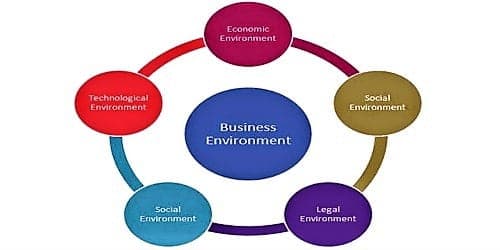Dimensions of Business Environment
Dimensions are the factors constituting the business environment include economic, social, technological, political and legal conditions which are considered relevant for decision-making and improving the performance of an enterprise. However, management of every enterprise can benefit from being aware of these dimensions instead of being disinterested in them.

- Economic Environment
Interest rates, inflation rates, changes in disposable income of people, stock market indices and the value of rupee are some of the economic factors that can affect management practices in a business enterprise. Economic Environment consists of factors like inflation rates, interest rates, consumers’ incomes, economic policies, and market conditions, etc. which influence the performance of a business firm. Short and long term interest rates mainly influence the demand for goods and services.
For example, in the case of construction companies and automobile manufacturers, low longer-term rates are beneficial because they result in increased spending by consumers for buying homes and cars on borrowed money.
- Social Environment:
The social environment of business includes social forces like customs and traditions, values, social trends, society’s expectations from business, etc. It implies customs, literacy rates, learning levels, values, traditions, and way of life, demographic allotment and other characteristics of the society in which the organization exists. Traditions explain social practices that have persisted for decades or even centenaries.
For example, the health and fitness trend has become popular among a large number of urban dwellers. This has created a demand for products like organic food, diet soft drinks, gyms, bottled (mineral) water and food supplements.
- Technological Environment:
The technological environment includes forces relating to scientific improvements and innovations which provide new ways of producing goods and services and new methods and techniques of operating a business. It includes new approaches, new procedures, and new equipment to renovate inputs into outputs. It facilitates an organization’s competence and usefulness so that it can try to stay put at par with the best in the world.
- Political Environment:
Political environment includes political conditions such as general stability and peace in the country and specific attitudes that elected government representatives to hold towards business. It consists of forces such as political constancy and tranquility in the nation and approach of the ruling party and its representatives towards business. The significance of political situations in trade accomplishment rests in the obviousness of trade pursuits under stable political situations. These forces considerably influence the implementation of business.
- Legal Environment:
The legal environment includes various legislations passed by the Government administrative orders issued by government authorities, court judgments as well as the decisions rendered by various commissions and agencies at every level of the government – center, state or local. It includes the laws conceded by the government as well as the decisions rendered by the various commissions and agencies at each level of the government. It is imperative for the management of every enterprise to obey the law of the land. It is essential for the management of every company to accept the law of the land. It’s significant that every business must function according to the law of the region in which it wishes to control.















